�
�
TextEdit Efficiency
�Is TextEdit just some icon hanging out in your Applications folder, going unlaunched?
�
If so, you're missing out on some good Mac Efficiency.
�
Let's have a look at just what it can do for you.
Great Uses for TextEdit
�- �
- TextEdit is great for note-taking.
� It launches in seconds and files can be saved to open in TextEdit or in Word.
� (Lots of loose note files may drive you crazy, so an app like TopXNotes and/or NoteBook serve great purposes too.) �
- Need to quickly read a Word file but don’t already have Word running?
� Just drag your .doc file onto it for a quick read. You can even edit the file and save it.
� TextEdit also reads and writes .rtf, or .rtfd files. (It can’t open Pages files.) �
- Collecting info from a web page? Select the text and drag it onto a TextEdit document.
� That text will come onto your page in all sorts of different fonts, sizes, bolding, italics...
� You’ll likely want to make it look more uniform. That’s where Styles come in.
� So keep reading. I’ve got you covered. �
- Another thing TextEdit is great for is making your own manuals.
� I make them all the time for myself and my clients. Any time you do something that you fear you won’t recall later. Perhaps it’s setting up your router with it’s username and password. Or maybe it’s setting up a look in Photoshop or on a web page. Start a TextEdit document and write down your steps. Take screen shots along the way and drag them in the document to remind yourself of what you did. When all the steps are done, save this and you have it for next time. (“Print” this as a PDF to lock in the steps.) �
Efficient text styling and ruler formatting in TextEdit
�By using a Style you can quickly apply a look to your text characters or even apply paragraph formatting. Rather than open the Fonts panel over and over, applying each format again and again, you can set up a single look — such as a color, or a collection of looks, such as red, bold, italic, and double underlined — then apply the entire look with one click-drag-release move.
�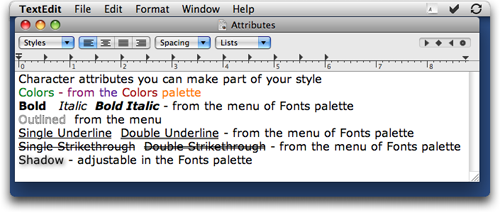 What kind of styles can you apply to your characters?
What kind of styles can you apply to your characters?
Any of the options available in the Styles menu or the Fonts palette.
�And... any combination, too, because you can combine multiple attributes into one Style so they’re all applied at once.
��
�
The efficiency challenge...
�By default, the Styles menu in TextEdit only offers bold, italic, outline and shadow styles.
�� The Style menu has another option — Other...
� and notice that it has an elipsis.�
To be Mac Efficient is to explore a menu item if it's got an elipsis.
�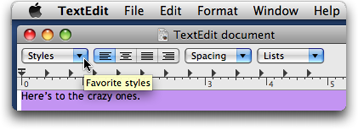

�
So our goal is to get your desired Styles into the Styles menu.
�
To Create a Style in TextEdit
�To create a style you have to have a document open, so open one now if you'd like to follow along.
�- �
- Select some text.
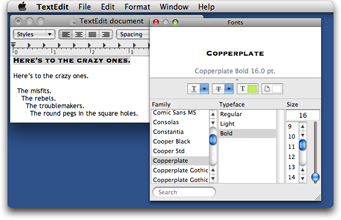 �
�
- Choose Format -> Show Fonts
� This brings up the Font panel, as shown. �
- In the Font panel, choose your look.
� Here, I choose a font family, typeface, and size.
�
�
�
�
�
�
�
�
�
�
�
�
� �
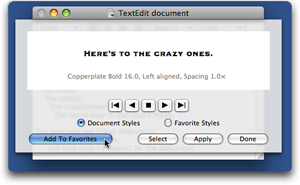 Return to the document,
Return to the document,
� then click on the Styles popup and choose Other.
� This brings down the styles sheet which shows a depiction of your selected text looking as if you fromattd it and shows a the description that styling. �
- Keep the Document Styles button selected. �
- Click the Add to Favorites button, as I'm doing here.
� This opens another dialog window.
�
�
�
� �
- Name your style.
� I recommend a descriptive name so you know what you will get when you choose it later on.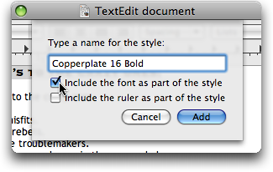
� Here, I named it Copperplate 16 Bold because those are the three attributes. �
- (Optional) Check Include the font as part of the style
� Without this checked, you’ll be setting up any of the things like Bold, color, shadow, etc. Any of the attributes shown in my colorful image at the top of this article. Just not the actual font that is currently applied to your text.
� In this case,if I did not check this, I'd be setting up a style that made any text 16 points and bold.
� By checking it, any selected text will also be changed to Copperplate.
�
� �
- (Optional) Check Include the ruler as part of the style
� Here, I do not want my text placement to change so it’s unchecked. For an example, see the sidebar that follows shortly. �
Your new style will now appear under the Style menu.
�� If you tend to use a color so you notice certain points, create a style that is just that color.
� (I have "Red.")
Apply a Style in TextEdit
�You can apply your Style to your text in any document you open in TextEdit.
�To apply a style...
�- �
- Select the text to which you want to apply that style. �
- Click the Styles menu, drag your mouse pointer down to the desired style, then release the button. �
Your selected text will immediately change to reflect the style.
�Sidebar: An example of ruler formatting
�Here I have a set of headings spaced out using tabs. Notice the custom tab spacking on the ruler.
�
I think I'll want to do this sort of date headings again some other time. So I create the style, checking only the ruler option.
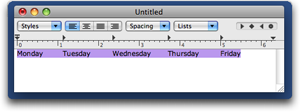
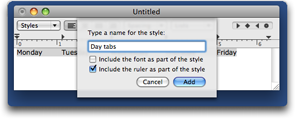
Later, I create a similar line of days of the week and want the same sort of spacing so I choose that style.
�


Notice that the font was entirely different in this second document and my style left the font face and attributes alone.
�To Delete a Style From Favorites
�At some time, you are bound to create a style you did not intend to or no longer want.
�
No problem! You are not stuck with it for as long as you have your Mac.
1) With any document open, choose Other from the Styles popup. Then...
�2) Click the Favorites button
�
This shows you a pop-up.
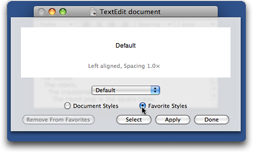
3) In the list of your styles, choose the one you want to delete.
�
4) Click the Remove from Favorites button.
�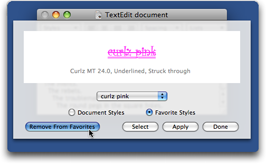
May you enjoy TextEdit's power now.
�[Note: This article was written during TextEdit version 1.5 under OS 10.5.4.]
� � Until next time...�
�
� PS: If you like this article and want more, please sign up to receive a simple email each time I publish a new piece. It's easy.
�
Thanks to...
�
Ettore Software and Mariner Software
�
for sponsoring this article.
�
� Visits to this page are tracked by statcounter.com � � � �
�



